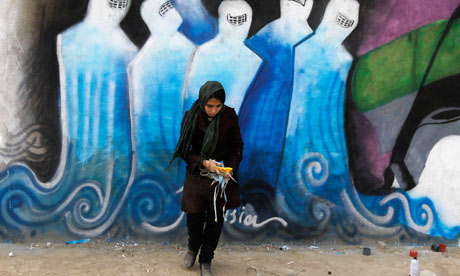M WAQAR..... "A man's ethical behavior should be based effectually on sympathy, education, and social ties; no religious basis is necessary.Man would indeed be in a poor way if he had to be restrained by fear of punishment and hope of reward after death." --Albert Einstein !!! NEWS,ARTICLES,EDITORIALS,MUSIC... Ze chi pe mayeen yum da agha pukhtunistan de.....(Liberal,Progressive,Secular World.)''Secularism is not against religion; it is the message of humanity.'' تل ده وی پثتونستآن
Saturday, February 25, 2012
Art in the streets of Kabul
Inside the blackened ruin of Kabul's cultural centre, a spray-painting of a woman in a burqa sits at the foot of a staircase to nowhere, beside a line of poetry mourning everything that has been lost to Afghanistan in three decades of violence.
The painting is the work of Shamsia Hassani, 24, probably her country's first serious graffiti artist.
"The water can come back to a dried-up river, but what about the fish that died?" is her translation of the line, written under gaping holes gouged through the concrete walls by shells when battles raged through the area.
"When I heard this poem, I thought how it was about the situation in Afghanistan. A lot of people died in the war; now the situation is better, but those people cannot come back," said Hassani.
An associate professor of sculpture at Kabul University, she draws, paints in oil, and is a founding member of a contemporary art collective, Rosht, or "growth". She was introduced to graffiti when a British artist, Chu, flew out in late 2010 to hold a week-long course in street art.
She has embraced the discipline. Spray cans and stencils have more impact than traditional art, she says, because the latter is a luxury.
"If you have an exhibition, most uneducated people won't even know about it."
" But if you have art like graffiti in the street, everyone can see that … If we can do graffiti all over the city, there will be nobody who doesn't know about art."
The obstacles in a city at war, policed by jittery security forces, discouraged most other students on Chu's course, even though the high walls and giant concrete blast barriers are a tempting blank canvas.
For women, there is also street harassment; even those who go out wearing the all-enveloping burqa can meet leering compliments on their hands and ankles.
So Hassani works in industrial yards and abandoned buildings, such as the cultural centre.
Or she does fantasy graffiti. "If you stand in the street, you face problems; because of this I started a new style of graffiti. I take pictures of places I like in the city, open them in a programme like Photoshop, and do digital designs. Or I print out a picture of the street and then do graffiti with a paintbrush. If you scan it back, it looks like real graffiti, but of course it isn't."
A lot of her work features women in burqas, but with a modern silhouette, with hips and sharp shoulders; or fish, trapped and silent in their watery universe.
Hassani's family are originally from Kandahar, Taliban's heartland, but she was born in Iran where her parents were refugees.
"I started art like everyone, when I was a child, but most people give it up. I had no teacher, but I continued."
When she reached ninth grade, when art classes begin in Iran, she was told they were not open to Afghans, so she studied accountancy instead.
When the family returned to Kabul, she made up for lost time at the University art department, but chaffed at the traditional bias, and started exploring contemporary art. Now as a professor she hopes to start a graffiti class and bring art to the city.
"If just 20% of students were interested, if every year we graffiti twenty walls around Kabul, in two or three years we will have lots of art on walls around the city."
"Art can bring change, I am sure. If people see an artwork, it will perhaps only cause a small shock to their mind, but that can grow and grow."

No comments:
Post a Comment